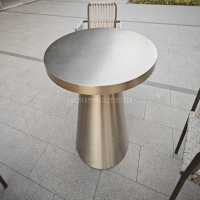Welcome to the website for landscape facilities products and knowledge.
How does the table’s design accommodate the needs of elderly or differently-abled users?
Modern table design has evolved significantly to meet the diverse needs of elderly individuals and users with varying physical abilities. The fundamental principle driving this evolution is inclusive design - creating products that serve the widest possible range of users without specialized adaptations.
Height adjustability represents one of the most crucial features in accessible tables. Electric or mechanical height-adjustable mechanisms allow users to customize table height from seated positions, including wheelchair users, to standing positions. This flexibility accommodates different mobility devices and user preferences while promoting proper posture and reducing strain.
Clearance specifications beneath tables are carefully engineered to accommodate wheelchair users. The standard 27-inch knee clearance and 30-inch width for leg space ensure comfortable access without obstruction. These measurements align with ADA guidelines while providing sufficient room for maneuverability and comfortable positioning.
Edge design and surface materials contribute significantly to safety and accessibility. Rounded corners prevent injuries for users with visual impairments or mobility challenges, while non-slip surfaces prevent items from sliding. Matte finishes reduce glare, which benefits users with light sensitivity or visual limitations.
Stability and support features address the needs of users who require assistance when rising or maintaining balance. Tables with sturdy bases and appropriate weight distribution prevent tipping when users apply pressure for support. Some designs incorporate grab bars or reinforced edges that can withstand pressure from mobility devices.
Control mechanisms prioritize simplicity and intuitive operation. Large, easy-to-grip knobs for manual adjustments or clearly labeled touchpad controls for electronic systems ensure users with limited dexterity or visual impairments can operate the table independently. Tactile indicators and high-contrast color schemes further enhance usability.
Material selection considers both durability and user comfort. Warm-to-touch surfaces that don't conduct cold, easy-to-clean materials that withstand frequent sanitation, and scratch-resistant finishes maintain the table's functionality and appearance through years of use.
The integration of technology enhances accessibility further, with some tables featuring USB charging ports at easily reachable locations, wireless charging surfaces that eliminate cord management challenges, and voice-activated height adjustment for users with severe mobility limitations.
These design considerations collectively create tables that promote independence, safety, and comfort for all users, demonstrating how thoughtful furniture design can remove barriers and create truly inclusive environments where age or ability doesn't limit participation in daily activities.
Related search:

Recommendation
Outdoor Metal Table - Classic Outdoor Furniture, Stainless Steel Table, Durable and Reliable